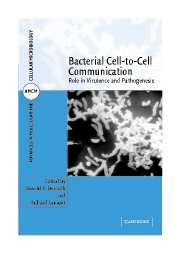Book contents
- Frontmatter
- Contents
- List of Contributors
- Preface
- 1 Quorum sensing and regulation of Pseudomonas aeruginosa infections
- 2 The Pseudomonas aeruginosa quinolone signal
- 3 Quorum-sensing-mediated regulation of plant–bacteria interactions and Agrobacterium tumefaciens virulence
- 4 Jamming bacterial communications: new strategies to combat bacterial infections and the development of biofilms
- 5 Quorum-sensing-mediated regulation of biofilm growth and virulence of Vibrio cholerae
- 6 LuxS in cellular metabolism and cell-to-cell signaling
- 7 LuxS-dependent regulation of Escherichia coli virulence
- 8 Quorum sensing and cell-to-cell communication in the dental biofilm
- 9 Quorum-sensing-dependent regulation of staphylococcal virulence and biofilm development
- 10 Cell-density-dependent regulation of streptococcal competence
- 11 Signaling by a cell-surface-associated signal during fruiting-body morphogenesis in Myxococcus xanthus
- Index
- Plate Section
- References
3 - Quorum-sensing-mediated regulation of plant–bacteria interactions and Agrobacterium tumefaciens virulence
Published online by Cambridge University Press: 08 August 2009
- Frontmatter
- Contents
- List of Contributors
- Preface
- 1 Quorum sensing and regulation of Pseudomonas aeruginosa infections
- 2 The Pseudomonas aeruginosa quinolone signal
- 3 Quorum-sensing-mediated regulation of plant–bacteria interactions and Agrobacterium tumefaciens virulence
- 4 Jamming bacterial communications: new strategies to combat bacterial infections and the development of biofilms
- 5 Quorum-sensing-mediated regulation of biofilm growth and virulence of Vibrio cholerae
- 6 LuxS in cellular metabolism and cell-to-cell signaling
- 7 LuxS-dependent regulation of Escherichia coli virulence
- 8 Quorum sensing and cell-to-cell communication in the dental biofilm
- 9 Quorum-sensing-dependent regulation of staphylococcal virulence and biofilm development
- 10 Cell-density-dependent regulation of streptococcal competence
- 11 Signaling by a cell-surface-associated signal during fruiting-body morphogenesis in Myxococcus xanthus
- Index
- Plate Section
- References
Summary
INTRODUCTION
Plant-associated bacteria have a wide range of interactions with their hosts, from non-specific associations to more dedicated symbiotic or pathogenic interactions. Many complex interactions take place between plant roots and associated bacteria, fungi, and protozoa in a highly diverse and dense community within the rhizosphere. Bacterial cell-to-cell communication systems in this ecological niche appear to affect biofilm formation, pathogenesis, and production of siderophores and antibiotics. These activities are no doubt important in root colonization as well as in symbiosis and pathogenesis. Exciting developments and current studies in understanding the many complex interactions in the rhizosphere include both the characterization of the microbial communities involved and the responses of the plant hosts to these communities. Cell-to-cell signaling between members of the community is no doubt critical for these interactions to sense population densities and diffusion barriers in the rhizosphere. Such studies are beyond the scope of this chapter, but we refer the reader to recent reviews of this field (43, 65, 82).
Perhaps the best-characterized group of soil bacteria that serves as the model for understanding plant–bacteria associations is the Rhizobiaceae. This family, in the alpha subgroup of the Proteobacteria, includes members of the genera Rhizobium, Sinorhizobium, Mesorhizobium, Azorhizobium, and Bradyrhizobium (collectively referred to here as rhizobia), which form symbiotic relationships with host plants, and several pathogenic species of the genus Agrobacterium (including A. tumefaciens, A. rhizogenes, A. vitis, and A. rubi, here referred to as agrobacteria).
- Type
- Chapter
- Information
- Bacterial Cell-to-Cell CommunicationRole in Virulence and Pathogenesis, pp. 39 - 64Publisher: Cambridge University PressPrint publication year: 2006



